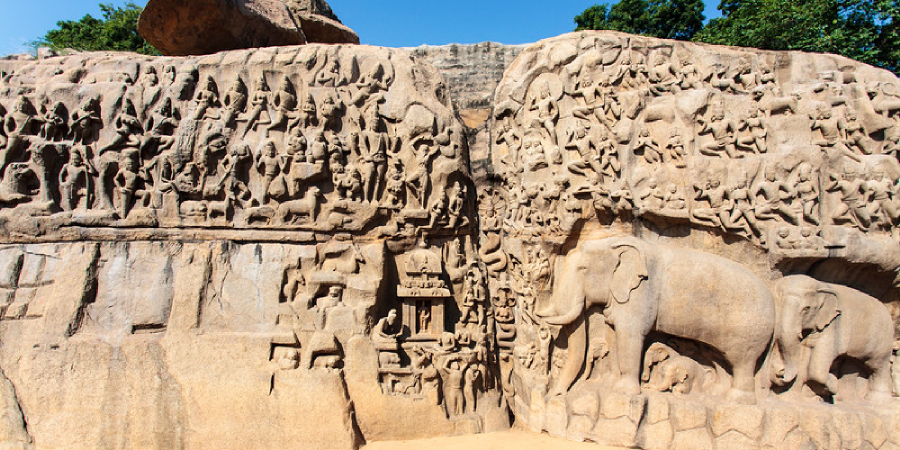Arjuna’s Penance, Mahabalipuram - Exploring the Brilliance of Ancient Stone Art in India
Mahabalipuram or Mamallapuram is one of the most ancient port cities in the Kancheepuram district of Tamil Nadu. Once a busy trading centre and a bustling seaport, the place is now one of the foremost tourist attractions in South India. The well-preserved history and heritage of the city speaks volumes of its glory.Once ruled by the Pallavas, Mahabalipuram is praised for their excellent contribution towards architecture and sculptures. The amazing rock-cut monuments have been a magnet for history enthusiasts, architects, and travellers from across the globe. The city is equally famous as a beach destination, monoliths, stone carvings and temples.
Mahabalipuram is commonly referred to as Bhagiratha's Penace. You can see the Arjuna’s Penance, at a distance of 0.5 km (0.3 mi) from Mahabalipuram Bus Station. The structure is basically an enormous open air bas-relief monolith, and it dates back to the 7th century CE. Measuring about 96 feet in length by 43 feet in height, the bas-relief referred as ‘The Descent of Ganga’. It has been assigned as a UNESCO World Heritage Site for the part of 'Group of Monuments at Mahabalipuram'.

Arjuna's Penance with Exquisite Bas-relief
|
Why is this place popular?
Arjuna’s Penance, Mahabalipuram is a magnificent structure carved out in rocks that depicts the mythological characters and their stories. This stonework masterpiece is one of India’s greatest ancient artworks that have been well preserved by the authorities. The structure was built by the Pallava King, Narasimha Varma, who was referred to as the ‘Ocean of the Arts’ in the 7th Century. Till date, of all the rock monuments that have been exhumed, Arjuna’s Penance, Mahabalipuram is one of the top stone structures made from granite rock boulders.Mythologically, the story goes such that Arjuna was practicing penance to get Lord Shiva’s weapon which he needed to fight the Mahabharata war. He strongly believed that if you have the will for self-mortification, the universe showers its abundant blessing; and rightly so, Arjuna was given the ‘weapon’.
Another belief goes that the subject of this massive structure is the ‘Descent of the Ganges’. It was formed when Bhagiratha offered his prayers to Lord Shiva and was practicing penance to urge river Ganga flowing on the Earth. However, there is no proper proof of any of these facts and continues to be a mystery.
An interpretation of Arjuna’s Penance, Mahabalipuram
• Scene 1: Penance
According to the experts, this could be either Sage Bhagirath or Arjuna. There is a geese couple on the right of the Penace. Chandra – the moon god is seen above Shiva.• Scene 2: The five Dwarves
Around the sculpture of Shiva, you’d notice five dwarves which is the representation of five elements – air, earth, fire, space and water. Some also like to correlate to the five senses.• Scene 3: Pashupatha
This little dwarf is said to be the personification of the Pasupatha weapon - an extremely powerful weapon that can even be destructive for gods. According to the epic Mahabharat, it was sought by Arjuna so that he could defeat the Kauravas.• Scene 4: The Sun God and Celestials
Surya the Sun God is seen being accompanied by divine beings; such as; Kinnaras (the musicians), flying Gandharvas, and the dwarves (Bhuta Ganas). It is believed that Gandharvas are celestial musicians. You can identify the Kinnaras as they have heads of men and bodies of birds / horses.• Scene 5: Elephants
This is, according to many, is the finest elephant sculptures in India, and signifies Lord Indra. Airavata, the mount of Lord Indra, is also seen to have bifurcated tusks as depicted in this relief.• Scene 6: The Cat
This is again based on one of the many folk stories you can find in Panchatantra stories, hugely popular in India. It is the cat who pretends to be extremely pious, so much so that the birds trust it to guard their nest. But the cat soon comes out with its true nature and feasts on the young nestlings. The birds, remorseful pledges not to trust any cat ever.• Scene 7: The Hermitage of Badari
This is a beautiful depiction of the co-existence of the deer and lion, which signifies the beauty of harmonious living. You can also see some common riverbank scenes such as worshipping, people bathing, and likewise.• Scene 8: Headless Hermits
There are two interpretations of the portrayal.Some historians consider these hermits as Dronacharya and Sage Agasthya while others view this as the Pallava kings whose descendants commissioned this relief. It is largely assumed that the Chalukya forces destroyed the sculptural heads.
Earlier Prime Minister Indira Gandhi, on her visit to Mahabalipuram and seeing the beautiful sculptures of Arjuna’s Penance where a deer featuring under the Badari Hermitage was included in the then 10-rupee note!
Quick facts
• Timings : 6:00 AM - 6:00 PM, all day of the week
• Best time to visit : winters months from November to February is the ideal time
• Trip duration: 1-2 hrs
• Entry Fee : Presently, the foreign nationals are charged INR 250
• Photography: Allowed for free
• Videography: Chargeable
• Popular amongst : History buffs and experience seekers
Nearby attractions of Arjuna’s Penance, Mahabalipuram
• Mahabalipuram Light House
• Maritime Heritage Museum
• Seashell Museum
• Panch RathasGetting there
Chengalpattu which is about 22 km (about 14 mi) is the nearest railway station to Mahabalipuram. However, the major railhead is Chennai which is 60 km (38 mi) from the city and connects major cities of India such as Delhi, Bangalore, Mumbai and Kolkata.Chennai international airport is the nearest airport which is around 58 km (35 mi approximately) away.
You can find plenty of private and public buses connecting the railway station and airport to the rest of the city.

